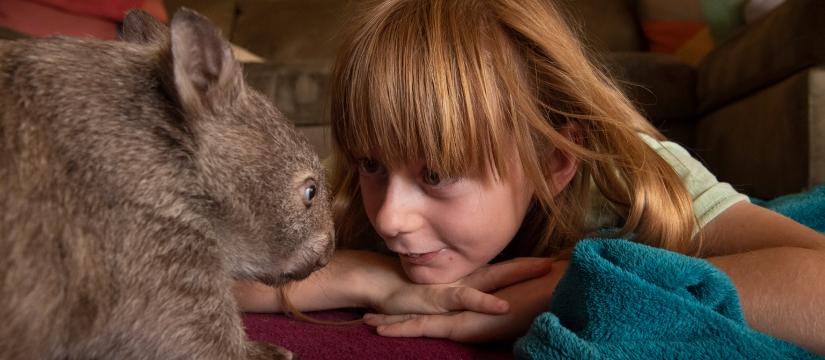
Wombat lovers – Donna and Jade Stepan
In the aftermath of last summer’s devastating bushfires, carer Donna Stepan found Chari, a bare-nosed wombat, struggling to survive in the blackened landscape.
Named after her charcoaled surroundings, the orphan was taken to Sleepy Burrows Wombat Sanctuary near Gundaroo in NSW, founded by Donna in 2004 and dedicated to helping orphaned, injured or traumatised wombats. “My passion is to work as best I can to ensure they have a safe place,” she says.
At the sanctuary, Chari and more than 70 other wombats receive 24-hour care, including bottle-feeding, often by Donna’s 10-year-old daughter, Jade, also a passionate animal carer.
Classified as a teenage wombat, Chari would have been completely dependent on her mother, necessitating specific care at the sanctuary.
“The irony with wombats is that as strong as they are, and they are one of the most powerful animals on the planet, you can actually kill them with stress,” says Donna.
“It’s paramount that you think about where they’d be with their mother in the bush, under what circumstances, and you replicate that. You want them drinking, eating and sleeping comfortably within 24 to 48 hours.”
For most wombats, rehabilitation takes two to three months, but many require more in-depth help over several years. Some stay forever.
“One of our core things is to release them with actual skills to provide,” says Donna. “It's not just a case of bring into care, feed them up until they’re a certain weight and dump them in the bush. We don’t do that. So, it's a long process.”
Donna, who was awarded the Order of Australia Medal in 2017 for her service to animal welfare, says the sanctuary cares for up to 75 bare-nosed wombats at a time, some in enclosures and some living in the bush.
“At the moment it's like having 40 children at various ages,” says Donna. “The beauty is they don't talk back.”
More than 700 wombats have been rehabilitated since the sanctuary was established and Donna has dedicated her life to helping the iconic Australian marsupial survive the effects of bushfires, land development and animal cruelty.
Her caring crusade began nearly two decades ago after she watched a vehicle carrying three men leave the road to deliberately hit a wombat.
“I work 18 hours a day, 365 days a year,” says Donna. “But if I struggle physically or mentally with the workload, I remember that evening and it gives me the strength to carry on. The sanctuary was created as a result of that action, so a very bad situation turned into a positive long-term one for wombats.”
Made redundant from IBM six years ago, Donna feared the sanctuary, which she funded herself and worked on in her spare time, would fold.
“I cried for several days but I realised that I had to keep the sanctuary going, I had to find a way to do it, and the rest is history,” she says.
Donna, who is originally from South Africa and lives with her partner Phil and children, Jade, 10, and Rebecca, 8, is also spearheading new treatments to help wombats affected by sarcoptic mange, a devastating condition that has decimated the species’ population in NSW, Victoria and Tasmania.
She has inspired her children to be passionate about animal welfare and both help by cleaning enclosures, washing wombat pouches and blankets and cutting grass for the wombats to eat.
“This species is not going to last much longer,” says Donna. “The population is in a lot of trouble. We’ve just got to work with the strongest of the species and hope that we can save them quicker than the way they're losing their habitat.
“We see wombats out in the bush now that we released up to 15 years ago, when the sanctuary started, so it's worth it.
“And, any wombat that survives in this day and age, in this environment with all the elements that man has thrown at it, is simply incredible.”



